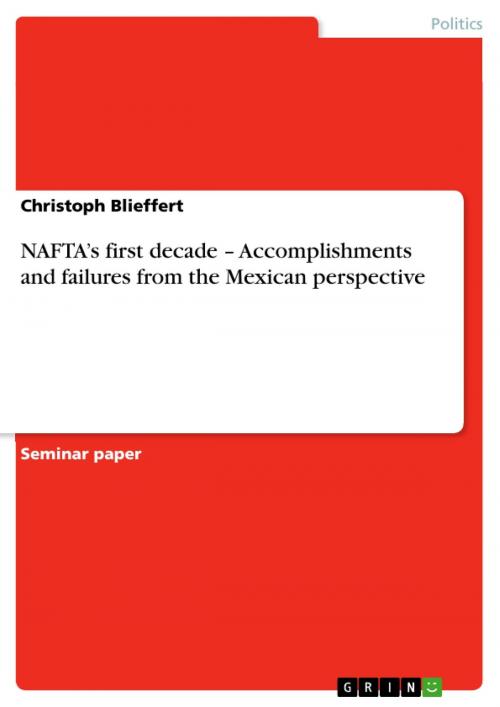NAFTA's first decade - Accomplishments and failures from the Mexican perspective
Accomplishments and failures from the Mexican perspective
Nonfiction, Social & Cultural Studies, Political Science, International, International Relations| Author: | Christoph Blieffert | ISBN: | 9783638058520 |
| Publisher: | GRIN Publishing | Publication: | June 5, 2008 |
| Imprint: | GRIN Publishing | Language: | English |
| Author: | Christoph Blieffert |
| ISBN: | 9783638058520 |
| Publisher: | GRIN Publishing |
| Publication: | June 5, 2008 |
| Imprint: | GRIN Publishing |
| Language: | English |
Seminar paper from the year 2007 in the subject Politics - International Politics - Region: Middle- and South America, grade: 1,0, Friedrich-Alexander University Erlangen-Nuremberg, 29 entries in the bibliography, language: English, abstract: On January 1, 1994, Mexico, Canada, and the United States established the largest free trade area under the North American Free Trade Agreement (NAFTA) after two and a half years of negotiation. This agreement created a free trade area on the North American subcontinent with approximately 431 million inhabitants and a GDP of about $15.3 trillion in 2006. NAFTA represented an important milestone in global trade policy, not just because of the sheer size of the free trade area it has created, but also with regard to the comprehensiveness of the agreement. It covered not just merchandise trade but also issues related to investment, environmental policies, energy generation, and labor markets. NAFTA's primary goal was the creation of a free-trade area with free movement of goods, service and capital, but no common market. In order to prevent the abuse of different external import tariffs, NAFTA implemented strict rules of origin. NAFTA is focused on economic cooperation and does not - in contrast to the European Union - intend a deeper political integration or the transfer of national sovereignty to a supranational organization. The creation of NAFTA is based on the fact that three countries, despite different size, economic structure, and ethnical background pursued the same goal, the establishment of a closer regional economic integration. Differences in economic terms between the member countries can be clarified by the distribution of NAFTA's GDP in 2006. More than 86.2 percent of NAFTA's total GDP was generated by the United States whereas Mexico contributed only 5.5 percent, which reflects the state of Mexico's economic development. Additionally, the Mexican GDP per capita amounted to only 18 respectively 20 percent of the GDP per capita in the United States and Canada.4 This heterogeneity between the three participating countries may be the most significant aspect of this agreement. This paper discusses NAFTA's accomplishments and failures after its first decade from the Mexican perspective as the agreement has been confronted with skepticism from its inception until today. While Mexican officials understood NAFTA as a measure to modernize the country through free trade, critics feared the transformation of the Mexican economy to a huge maquiladora where investors are mainly focused on the exploitation of Mexico's low labor costs.5 Since the beginning of negotiations, Mexico's former President Salinas has raised high expectations on the Mexican side in economic and social terms with his statement: 'The whole point of NAFTA for Mexico is to be able to export goods and not people. That means creating jobs in Mexico.' In order to highlight whether NAFTA resulted in economic as well as social improvements, this paper focuses on a comparison of these two aspects.
Seminar paper from the year 2007 in the subject Politics - International Politics - Region: Middle- and South America, grade: 1,0, Friedrich-Alexander University Erlangen-Nuremberg, 29 entries in the bibliography, language: English, abstract: On January 1, 1994, Mexico, Canada, and the United States established the largest free trade area under the North American Free Trade Agreement (NAFTA) after two and a half years of negotiation. This agreement created a free trade area on the North American subcontinent with approximately 431 million inhabitants and a GDP of about $15.3 trillion in 2006. NAFTA represented an important milestone in global trade policy, not just because of the sheer size of the free trade area it has created, but also with regard to the comprehensiveness of the agreement. It covered not just merchandise trade but also issues related to investment, environmental policies, energy generation, and labor markets. NAFTA's primary goal was the creation of a free-trade area with free movement of goods, service and capital, but no common market. In order to prevent the abuse of different external import tariffs, NAFTA implemented strict rules of origin. NAFTA is focused on economic cooperation and does not - in contrast to the European Union - intend a deeper political integration or the transfer of national sovereignty to a supranational organization. The creation of NAFTA is based on the fact that three countries, despite different size, economic structure, and ethnical background pursued the same goal, the establishment of a closer regional economic integration. Differences in economic terms between the member countries can be clarified by the distribution of NAFTA's GDP in 2006. More than 86.2 percent of NAFTA's total GDP was generated by the United States whereas Mexico contributed only 5.5 percent, which reflects the state of Mexico's economic development. Additionally, the Mexican GDP per capita amounted to only 18 respectively 20 percent of the GDP per capita in the United States and Canada.4 This heterogeneity between the three participating countries may be the most significant aspect of this agreement. This paper discusses NAFTA's accomplishments and failures after its first decade from the Mexican perspective as the agreement has been confronted with skepticism from its inception until today. While Mexican officials understood NAFTA as a measure to modernize the country through free trade, critics feared the transformation of the Mexican economy to a huge maquiladora where investors are mainly focused on the exploitation of Mexico's low labor costs.5 Since the beginning of negotiations, Mexico's former President Salinas has raised high expectations on the Mexican side in economic and social terms with his statement: 'The whole point of NAFTA for Mexico is to be able to export goods and not people. That means creating jobs in Mexico.' In order to highlight whether NAFTA resulted in economic as well as social improvements, this paper focuses on a comparison of these two aspects.















